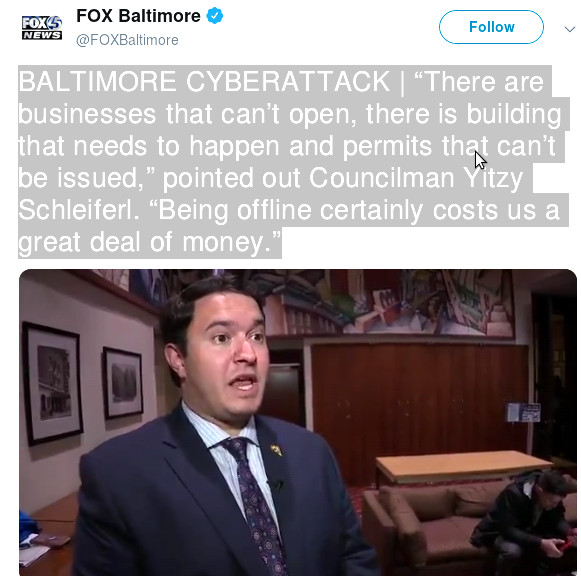scroll down for ENGLISH: )
OMG! Da die IT von Baltimore sich einen Ransome-Virus eingefangen hat, können die Bürger ihre Steuern und ihre Blitzer-Tickets nicht zahlen! Wunderbar! 🙂
Mit welchem Aufwand man rechnen muss, wenn man sich von der Digitalisierung mehr Effizienz verspricht, sieht man an diesem Beispiel eindrucksvoll.
D.h. theoretisch müsste jeder Server vor einem Update geklont werden – geupdated – anhand aufwändiger Test-Listen mit allen möglichen Test-Fällen getestet werden ob alle Funktionen nach dem Update noch funktionieren (s.h. Heise 2019-04: “Kampf gegen Bananen-Updates”) und dann erst das Update (nach einem Backup) auf dem Live-System durchgeführt werden.
Wer bezahlt diesen Aufwand? Erst mal niemand. Bis Baltimore passiert.
Jetzt könnte man sagen – okay – dann machen wir jetzt zentralistische Cloud-Systeme die ultra mega abgesichert sind “alles in the cloud” – aber man muss damit rechnen, dass speziell diese Ziele – aufgrund ihrer zentralen Lage im System – besonders interessante Angriffs-Ziele für KI-enhanced evtl. state-sponsored Hacker sind.
Aus der Biologie weiß man, dass eine Monokultur instabil ist – für Bugs – Schwachstellen, Schädlinge.
D.h. eigentlich bräuchte es eine IT-Biodiversität – d.h. die Microsoft Windows Monokultur ist schädlich für die Stabilität und Sicherheit der IT-Landschaft, auch wenn diese Einsicht nicht-Biologen nicht verstehen werden.
“Vor allem das Patch Management ist von grundlegender Bedeutung, wie das Beispiel Baltimore eindrucksvoll belegt. Bei einem Großteil aller Sicherheitsvorfälle sind nach Erfahrungswerten von NTT Security Verwundbarkeiten ungepatchter Systeme und Anwendungen im Spiel. Viele Angriffe und Schäden der vergangenen Jahre, etwa mit Wannacry oder Petya, hätte man so problemlos verhindern können.
»Und was die ganze Geschichte noch pikanter macht«, so Grunwitz, »Baltimore hat ambitionierte Ziele in Richtung Smart City. Erst im April 2019 wurde die Stadt auch als einer von fünf Gewinnern der ›Smart Cities Readiness Challenge‹ in den USA gekürt.«”
https://ap-verlag.de/cyber-security-so-vermeiden-unternehmen-ihr-eigenes-baltimore/53070/
PS: Naja ich denke die werden schon gute Backups haben oder? X-D (d.h. jemand der jede Woche eine Festplatte mit sich nach Hause trägt, mit dem kompletten Datensatz und diese in einem EMP-sicheren Case aufbewahrt… nein? schlecht)
PSS: Ja das zurück spielen des Backups dauert bestimmt mehrere Tage. Mal testen. Ist echt krass wie langsam USB 2.0 und 3.0 sind.
Im Falle von Baltimore dauert das zurück spielen scheinbar mehrere Wochen.
now finally: English
This example impressively shows how much effort you have to count on if you promise more efficiency from the digitisation.
That is, theoretically, each Server would have to be cloned before an Update is isntalled and thorough tested on the basis of complex test case lists with all possible Test cases – if all functions still work after the Update (i.e., Heise 2019-04: “battle against banana Updates”) and then the Update (after a Backup) are performed on the Live System.
Who pays for this effort? First of all no one. Until Baltimore happens.
Now you could say-okay-then we are now making centralized Cloud systems that are ultra mega secured “everything in the cloud” – but you have to expect that specifically these systems – due to their central location in the system – used by many US-cities all across the world – are particularly interesting attack targets for KI-enhanced possibly state-sponsored hackers.
From biology it is known that a monoculture is unstable – for Bugs-vulnerabilities, pests.
That is, it would actually need an IT biodiversity – that is, the Microsoft Windows monoculture is harmful to the stability and security of the IT landscape, even though this insight will not understand biologists.
“Patch Management, in particular, is essential, as Baltimore impressively demonstrates. Most of the security incidents involve vulnerabilities in unpatched systems and applications, according to the experience of NTT Security. Many attacks and damage of recent years, for example with Wannacrylic acid or Petya, could have been prevented so easily.
“And what makes the whole story even more piquant, “says Grunwitz,” Baltimore has ambitious goals towards Smart City. It was only in April 2019 that the city was named one of five winners of the “Smart Cities Readiness Challenge” in the USA.«”
Cyber-Security: So vermeiden Unternehmen ihr eigenes »Baltimore«
PS: well I think Baltimore has a good Backup system in place, right? (that is, someone who carries a 5TB hard drive home with him every week, with the complete data set and this stored in an EMP-secure vault… no? bad.)
PSS: yes restoring the backup will take several days – try it – it is really terrible how slow USB 2.0 and 3.0 are for data more than 1TB.
“in the case for Baltimore it’s a multi week process” holy cow… well i guess people are happy they can’t pay their speeding tickets X-D
liked this article?
- only together we can create a truly free world
- plz support dwaves to keep it up & running!
- (yes the info on the internet is (mostly) free but beer is still not free (still have to work on that))
- really really hate advertisement
- contribute: whenever a solution was found, blog about it for others to find!
- talk about, recommend & link to this blog and articles
- thanks to all who contribute!



